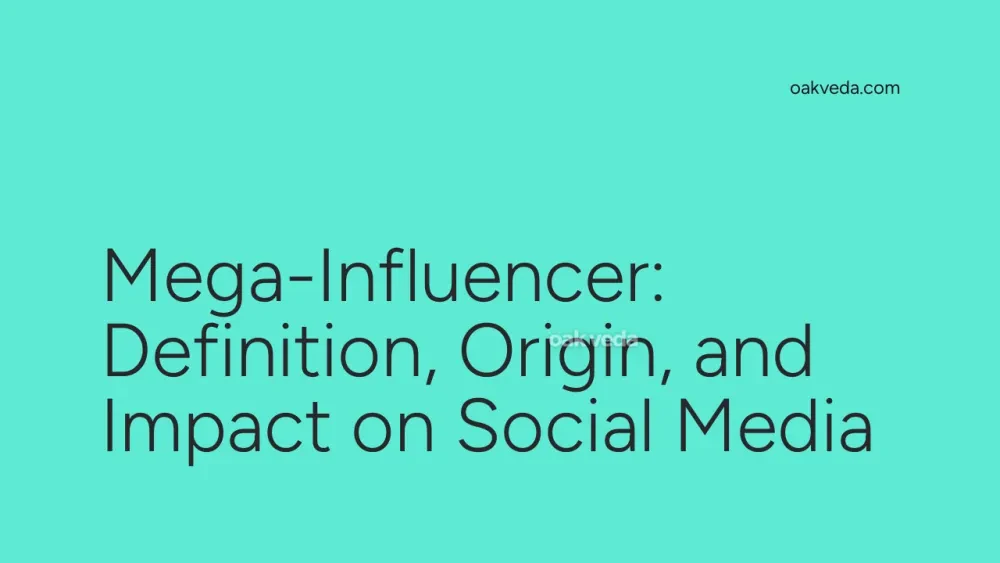
What is a Mega-Influencer?
A mega-influencer is a social media personality with an exceptionally large following, typically numbering in the millions across platforms like Instagram, YouTube, TikTok, or Twitter. These individuals are often celebrities, athletes, or public figures who have leveraged their fame to build a substantial online presence. Mega-influencers possess the power to reach and engage massive audiences, making them highly sought-after for brand collaborations and marketing campaigns.
Origin and Development of Mega-Influencers
The concept of mega-influencers emerged alongside the rise of social media platforms in the late 2000s and early 2010s. As these platforms grew in popularity, certain users began to amass enormous followings, transforming from regular content creators into digital celebrities. The term "mega-influencer" gained traction in the mid-2010s as marketers and brands recognized the potential of these social media powerhouses to reach vast audiences with a single post or video.
How Mega-Influencers Work
Mega-influencers operate by creating and sharing content that resonates with their massive follower base. Their influence stems from a combination of factors:
- Reach: The ability to connect with millions of followers instantly.
- Engagement: High levels of likes, comments, and shares on their content.
- Trust: A perceived authenticity and credibility among their audience.
- Trendsetting: The power to start or amplify trends in fashion, lifestyle, or consumer behavior.
These influencers often work with brands to promote products or services through sponsored content, endorsements, or long-term partnerships. Their massive reach allows them to command high fees for their promotional efforts, sometimes reaching hundreds of thousands of dollars for a single post.
Popular Examples of Mega-Influencers
Some well-known mega-influencers across various platforms include:
- Instagram: Cristiano Ronaldo, Kylie Jenner, Selena Gomez
- YouTube: PewDiePie, MrBeast, Jenna Marbles
- TikTok: Charli D'Amelio, Khaby Lame, Addison Rae
- Twitter: Barack Obama, Elon Musk, Taylor Swift
These individuals have followers in the tens or even hundreds of millions, giving them unprecedented reach and influence in the digital space.
Impact of Mega-Influencers on Social Media Culture
Mega-influencers have significantly shaped social media culture in several ways:
- Setting trends: They often dictate what's "in" in fashion, beauty, and lifestyle.
- Changing consumer behavior: Their recommendations can lead to instant sell-outs of products.
- Influencing public opinion: They can sway discussions on social and political issues.
- Redefining celebrity: Many mega-influencers have achieved fame primarily through social media, blurring the lines between traditional and digital celebrity.
Controversies Surrounding Mega-Influencers
Despite their popularity, mega-influencers are not without controversy:
- Authenticity concerns: As sponsored content becomes more prevalent, some followers question the genuineness of mega-influencers' recommendations.
- Transparency issues: There have been instances of mega-influencers failing to disclose paid partnerships, leading to legal and ethical concerns.
- Mental health impact: The curated lives of mega-influencers can contribute to unrealistic expectations and feelings of inadequacy among followers.
- Cancel culture: Mega-influencers are often subject to intense scrutiny, with missteps potentially leading to rapid "cancellation" by their audience.
How Brands and Influencers Use Mega-Influencers
Brands leverage mega-influencers in various ways:
- Product launches: To create buzz and drive initial sales for new products.
- Brand awareness: To increase visibility among a large, diverse audience.
- Reputation management: To associate their brand with a popular public figure.
- Content creation: To produce high-quality, engaging content featuring their products or services.
Mega-influencers, in turn, often use their status to:
- Launch their own brands: Many have successfully created their own product lines or companies.
- Support causes: They can raise awareness for charitable or social causes.
- Diversify income: Through sponsored content, merchandise, and appearances.
Future Trends Related to Mega-Influencers
The landscape of mega-influencers is continually evolving. Some emerging trends include:
- Increased scrutiny: Both audiences and regulators are demanding more transparency from mega-influencers.
- Niche specialization: Even within their large followings, mega-influencers are focusing on specific areas of expertise.
- Multi-platform presence: Mega-influencers are expanding their reach across multiple social media platforms.
- Virtual influencers: The rise of CGI-created mega-influencers like Lil Miquela challenges the notion of human celebrity.
- Micro-content focus: Platforms like TikTok and Instagram Reels are pushing mega-influencers towards shorter, more engaging content formats.
FAQs about Mega-Influencers
-
How many followers does a mega-influencer typically have? Mega-influencers usually have over 1 million followers, often reaching tens or hundreds of millions.
-
Are mega-influencers more effective than micro-influencers? While mega-influencers offer vast reach, micro-influencers often have higher engagement rates and more niche audiences, making them more effective for certain campaigns.
-
How much do mega-influencers charge for sponsored posts? Fees can range from tens of thousands to hundreds of thousands of dollars per post, depending on the influencer's reach and engagement rates.
-
Can anyone become a mega-influencer? While it's possible, becoming a mega-influencer typically requires a combination of unique content, consistency, timing, and often, pre-existing fame or exceptional talent.
-
How do brands measure the ROI of working with mega-influencers? Brands use metrics such as engagement rates, click-through rates, conversion rates, and overall reach to assess the effectiveness of mega-influencer partnerships.
In conclusion, mega-influencers represent a powerful force in the social media landscape, capable of shaping trends, influencing consumer behavior, and driving significant brand awareness. As the digital world continues to evolve, the role of mega-influencers will likely adapt, presenting both challenges and opportunities for marketers, brands, and the influencers themselves.
You may be interested in:
- Hot Girl Summer: Definition, Origin, and Impact
- Glow-Up: Definition, Origin, and Impact on Social Media
- Micro-Influencers: Definition, Origin, and Impact
- Unserious: Definition, Origin, and Impact on Social Media
- Krissed: Definition, Origin, and Impact on Social Media
- Brand Style Guide: Definition, Origin, and Impact

